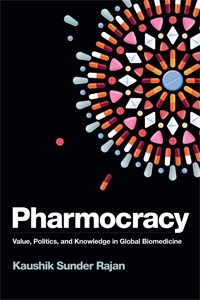Reviewed Book
Pharmocracy: Value, Politics, and Knowledge in Global Biomedicine. Kaushik Sunder Rajan. Durham: Duke University Press, 2017, 344 pp.

Kaushik Sunder Rajan’s highly anticipated book Pharmocracy: Value, Politics, and Knowledge in Global Biomedicine is a rich, multilayered look at the pharmaceutical industry in India. In five densely argued chapters plus an Introduction and Conclusion, Sunder Rajan provides an insightful analysis of the regimes of value of the Indian pharmaceutical industry as it has become increasing aligned with the multinational pharmaceutical industry.
On an empirical level, Pharmocracy provides a detailed account of the contested regimes of capital, democracy, and intellectual property in the pharmaceutical industry in India over the past dozen years. We learn about the evolving business models of Indian and multinational pharmaceutical companies; a nonprofit-funded vaccine implementation study that became a site of scandal and dissent; and landmark legislation and court cases that have transformed the legal landscape of pharmaceutical manufacture in a country that continues to be the major producer of low-cost generic drugs for global markets. Sunder Rajan recounts these complex events in a lucid, keenly observed way.
But it is the theoretical contribution that will likely be what draws most readers to the book. Pharmocracy presents a virtuosic theorization of the global pharmaceutical industry that is both grounded and far-reaching. Although the gesture toward “global biomedicine” in the book’s subtitle—without any countervailing local—might seem to imply an abstract approach not especially located time or place, Pharmocracy’s conceptual contributions to understandings of the pharmaceutical industry’s logics are made possible precisely through the very specific geographic (re)centering of analytical attention to contemporary India. It is from this location that Sunder Rajan rigorously works through the logics of 21st-century global (bio)capital. Sunder Rajan shows that India is a particularly revealing location from which to grapple with global pharma. In this sense, the empirical and the theoretical are deeply intertwined.
Chronologically, Sunder Rajan’s story starts in 2005, the year that marked the implementation of two sets of “harmonization” processes, in which Indian pharmaceutical regulations came into compliance with global standards of both intellectual property and clinical trials. Sunder Rajan points out that the beneficent-sounding term “harmonization” paves over the vital stakes of power. He argues that “global harmonization of clinical trials and intellectual property regimes must be understood in terms of expansion of multinational corporate hegemony” (p. 6). He is pointing to hegemony in a Gramscian sense: How it comes to be “common sense” that pharmaceuticals must generate maximal profit, and that innovation is more important than access.
Sunder Rajan describes how the reach of that multinational corporate hegemony became tested in the Indian Patent Office’s 2006 denial of Novartis’s patent of the expensive anticancer drug Gleevec, and in subsequent court cases at the at the Madras High Court and Indian Supreme Court in which the multinational company sought to restore the patent. Notably, the courts’ rulings resulted in a loss for big pharma and a victory for a coalition of Indian generic pharmaceutical companies seeking to protect their business model and social justice actors demanding expansive access to affordable medicines in India and globally. The regime of pharmocracy broadly operates in the interests of the multinational pharmaceutical industry, but Indian industry and institutions emerge as important, albeit insufficient and imperiled, checks on that power.
The Gleevec case has already been the subject of a tremendous amount of journalistic, activist, and scholarly analysis, but Sunder Rajan’s account is thorough and insightful. The clinical trial example that Sunder Rajan explores has been the subject of far less attention: a 2010 HPV vaccine implementation trial in which seven girls died. While these cases do not pertain directly to the major health issues facing Indians—the cancer that Gleevec treats is rare, and the frequency of child death from ambiguous causes itself makes the HPV vaccine case harder to get to the bottom of—Sunder Rajan uses them as concrete examples that allow exploration of far broader phenomena. He attends to ways in which relationships between regimes of value (including economic value and moral value) and regimes of knowledge (including intellectual property and democratic free press) are contested as health is appropriated by capital.
In terms of method, Sunder Rajan turns his ethnographic attention primarily to textual data, especially transcripts of parliamentary debates, legislation, and records of court cases. We are occasionally introduced to clinicians, activists, and politicians, but we really get to spend time with just one major figure in Indian pharma: the charismatic and visionary longtime chief of the important generic pharmaceutical company Cipla, Yusuf Hameid, whom Sunder Rajan has interviewed at length. Hamied’s articulation of a pharmaceutical capitalism that recognizes patents but denies monopoly is fascinating, and his provocation that the enforcement of global intellectual property regimes amounts to “selective genocide” (p. 196) is powerful.
In the book as a whole, interview material is dwarfed by Sunder Rajan’s far closer attention to documents. The focus on court cases and legislation is not the only possible route to exploring the terrain of pharmaceuticals in post-harmonization India. Indeed, Sunder Rajan started this project elsewhere, with fieldwork at contract research organizations that were running clinical trials, but he lost access to those sites when he took a public position critical of the enterprise that uses Indian bodies as research material without ever envisioning Indian patients as beneficiaries (p. 34). Nonetheless, legal texts are an excellent choice for Sunder Rajan’s project, because attending to documents allows a particular precision in the analysis of how language and logic operate.
Pharmocracy is successful in its endeavor “to provoke conceptual and political questions concerning how value, politics, and knowledge come to be related to one another in contemporary global pharmaceutical economies in ways that put both health and democracy at stake” (p. 36). The book will be of interest to not only to anthropologists of the pharmaceutical industry and anthropologists of India, but also to scholars from wide-ranging disciplines seeking empirical and theoretical tools for grappling with contemporary markets, politics, and health.